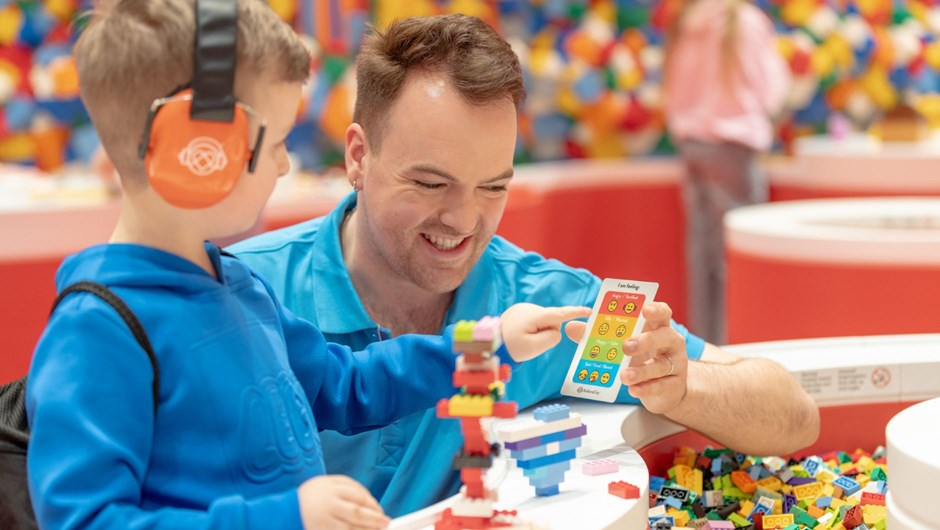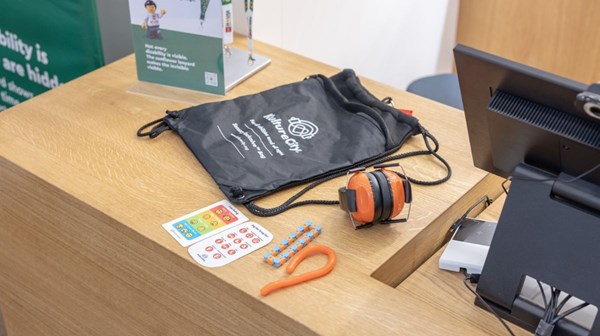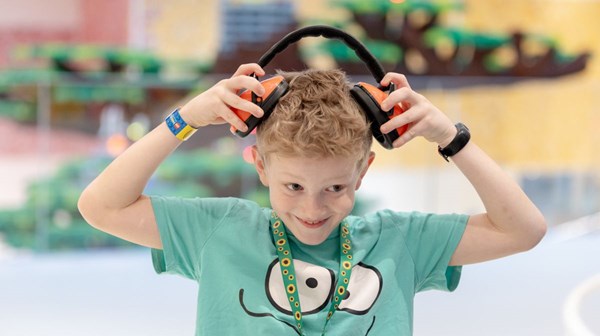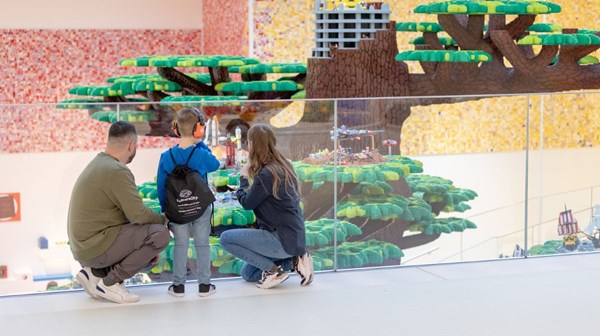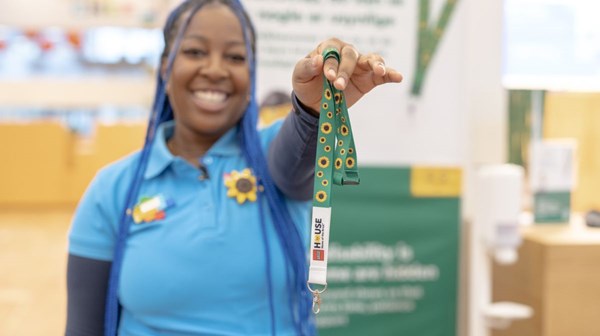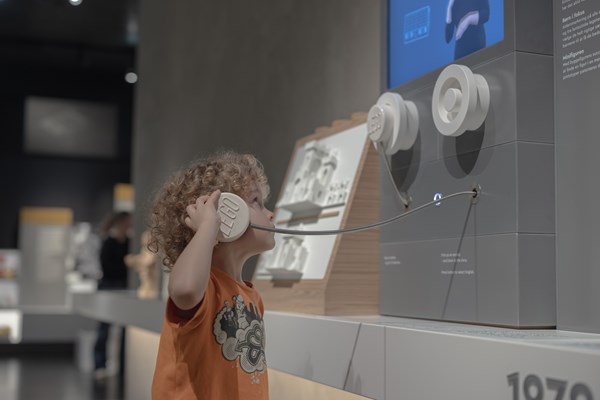Learning through Play should be an opportunity for everyone:
KultureCity® Sensory Inclusive™ certification makes LEGO® House accessible to even more guests
- LEGO® House is continuously being updated to become even more accessible and inclusive for all guests, including those living with physical disabilities or sensory needs
- Being the first Danish attraction to implement the Sunflower Lanyard – the experience house is now taking the next steps towards greater inclusion
- LEGO House is the first Nordic attraction to attain the KultureCity Sensory Inclusive Certification – making Learning through Play accessible to even more people
April 2, 2024, LEGO® House, Denmark: A visit to LEGO House, the iconic Home of the Brick in Billund, Denmark, stands as the ultimate bucket-list destination for many LEGO fans. Providing great play experiences for all has been an integral part of its mission since opening in 2017. Whilst ensuring LEGO House allows every visitor to feel welcome and supported is a constant journey, 2024 brings new initiatives aimed at enhancing accessibility even further.
This year sees improvements made to the Experiences Zones, exhibitions, staff training, and social spaces of the House to foster greater inclusivity and accessibility. The changes have been introduced to support particularly visitors with physical disabilities or sensory needs, such as fans who are autistic or have ADHD or PTSD. It will also accommodate guests with sensory impairments like vision or hearing loss, as well as those living with various mobility impairments.
”Ensuring every LEGO fan feels welcome and included when visiting LEGO House is a cause extremely close to my heart. My personal experience of raising an autistic daughter means I can relate to the considerations and concerns that parents in similar situations may face when visiting attractions such as our very own Home of the Brick” says Kathrine Kirk Muff, Managing Director, LEGO House.
A fundamental principle of the LEGO Group's philosophy is that Learning through Play nurtures qualities that encourage positive connections with the world, innovation, and inspires change. Comprising of four totally unique Experience Zones, nine rooftop playgrounds, and an immersive LEGO Museum, LEGO House reinforces the importance of the five key skills that are developed when learning through play - physical, social, emotional, cognitive and creative skills. Since its opening in 2017, inclusivity and accessibility have been central to LEGO House's mission to ensure that everyone can learn through play. Consistent improvements have been made year on year, with LEGO House being the first Danish attraction to introduce the globally-recognized Sunflower Lanyard program.
LEGO house also installed a changing space - a fully accessible restroom with hoist, changing benches and shower facilities. These assistive devices are essential for some guests and the special toilet will enable a new group of guests and their families to enjoy LEGO House.
Achieves international certification as the first attraction in the Nordics
LEGO House is the first attraction in the Nordics to achieve Sensory Inclusive Certification from KultureCity, a non-profit organization dedicated to enhancing accessibility for individuals with heightened sensitivity and other special needs. As a part of the certification, the employees at LEGO House have undergone training, and physical alterations have been implemented.
“We're proud to be the first attraction in the Nordics to achieve the KultureCity certification, and we hope it will make a positive change for visitors who otherwise might feel nervous or hesitant about visiting. We see this certification as a natural extension of the Sunflower Lanyard. While the Sunflower Lanyard primarily is used as a signal to indicate to other guests or staff that one may need extra support, time, or patience, the initiatives that accompany the KultureCity certification are more concrete and physical aids. A significant aspect is the crucial training of employees to equip us to create the best conditions for providing a great experience for all our guests” says Kathrine Kirk Muff.
Among the physical improvements made as part of achieving the certification, LEGO House provides loanable bags, which function as small support kits that visitors can take with them around the House.
The KultureCity sensory bags include the following:
- Noise-reducing headphones: To help reduce environmental noise for anyone experiencing auditory sensitivity.
- Strobe glasses: To reduce visual information.
- Fidget tools: To help regulate feelings and support stimming.
- Visual Mood Cards: To support communication.
Updated History Collection
The History Collection is the official LEGO museum at LEGO House. Here, guests can explore the more than 90-year-long LEGO history as well as iconic LEGO sets.
As something new for the 2024-season, the History Collection now features an engaging and interactive timeline with animations supported by audio, Braille, and International Sign to increase accessibility, and providing all visitors with a playful and immersive journey through the remarkable LEGO history.
In order to establish a more tangible connection to the LEGO Group’s past, physical objects are positioned along a physical guidance path, enabling visitors to touch and interact with iconic creations like the Wooden Duck, the Yellow Castle, and the minifigure. These additions aim to significantly enhance the experience for guests who are partially sighted and blind, partially hearing and deaf, as well as anyone else.
Interviews with Kathrine Kirk Muff, Managing Director of LEGO House, are available upon request.
Facts:
About KultureCity
KultureCity®, established in 2014, is a dynamic non-profit organization at the forefront of the inclusivity movement which continues to make waves in creating a more accessible and accepting world for individuals with sensory needs and invisible disabilities (found in 1 in 4 of us).
In a short 10 years, a few highlights of KultureCity’s impact includes making over 1,800 venues sensory inclusive certified, handing out almost a million sensory bags to individuals, making over 150 live events sensory inclusive, and saving 48 lives through the KultureCity® First Responder Training. KultureCity’s commitment to inclusivity extends beyond physical spaces. The organization actively collaborates with influential figures, businesses, and communities to promote awareness and understanding of invisible disabilities. KultureCity® partners with event industry leaders like NFL, NBA, MLB and FIFA to make their flagship events sensory inclusive. With ongoing initiatives, partnerships, and a passionate community of supporters, KultureCity® is set to leave an enduring impact on the landscape of inclusivity.
Read more here.
Sunflower Lanyard
The Sunflower Lanyard is a globally recognised scheme where individuals with hidden disabilities can indicate that they may need additional support or understanding in public settings. By wearing the lanyard, individuals signal to staff and others that they may require assistance, patience, or accommodations. LEGO House adopted the Sunflower Lanyard scheme in 2021 to enhance inclusivity and provide a more supportive environment for those with hidden disabilities.
Read more here.
Notes to editors
We use identity-first language (autistic child) rather than person-first language (child with autism) to discuss autistic guests. We acknowledge that there is no clear consensus globally within the autism community, and many views have yet to be researched, regarding preferred language and there are those who prefer person-first language (Dwyer, 2022).
Identity-first language seeks to move away from language that can pathologize neurological difference (Botha, Hanlon & Williams 2021). It instead recognises autism as a core part of someone’s identity.
Using identity-first language such as “autistic young people” emphasises the importance of the opinion of autistic adults when it comes to talking about people who are autistic. To avoid repetition throughout an article, “on the autism spectrum” or “on the autistic spectrum” were considered acceptable by all groups and can therefore be used as well.

